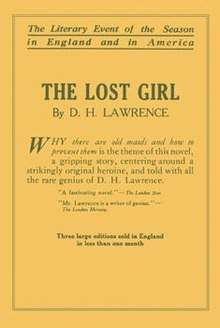The Lost Girl
The Lost Girl is a novel by D. H. Lawrence, first published in 1920. It was awarded the 1920 James Tait Black Memorial Prize in the fiction category. Lawrence started it shortly after writing Women in Love, and worked on it only sporadically until he completed it in 1920.[2]
 First US edition | |
| Author | D. H. Lawrence |
|---|---|
| Country | United Kingdom |
| Language | English |
| Publisher | Martin Secker (UK) Thomas Seltzer (US) |
Publication date | 1920[1] |
| Media type | Print (Hardcover, Paperback) |
| Pages | 371 |
| OCLC | 432428229 |
| 823/.912 19 | |
| LC Class | PR6023.A93 L62 1981 |
| Preceded by | Women in Love |
| Followed by | Aaron's Rod |
Synopsis
Alvina Houghton, the daughter of a widowed Midlands draper, comes of age just as her father’s business is failing. In a desperate attempt to regain his fortune and secure his daughter’s proper upbringing, James Houghton buys a theater. Among the traveling performers he employs is Ciccio, a sensual Italian who immediately captures Alvina’s attention. Fleeing with him to Naples, she leaves her safe world behind and enters one of sexual awakening, desire, and fleeting freedom.
Editions
- The Lost Girl (1920), edited by John Worthen, pub. Cambridge University Press, 1981, ISBN 0-521-22263-X.
- The Lost Girl, pub. New York: Thomas Seltzer, 1921. Online edition at Google Books. Snippet view, United States Only.
References
- Facsimile of the 1st edition (1920)
- ‘The Lost Girl’ JUNE 23, 2005, Lee Siegel New York Review of Books, 2005.
External links
- The Lost Girl at Project Gutenberg
- Second edition at the Internet Archive
